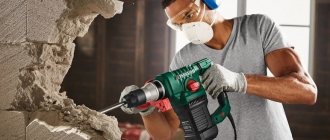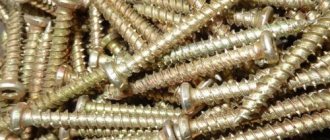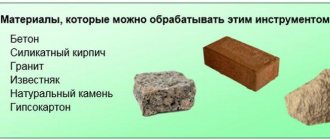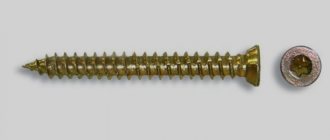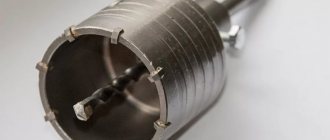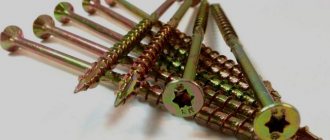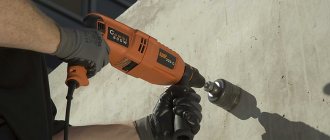To install a window block into a concrete wall, attach a wall cabinet to it, or hang a lamp from the ceiling, you need a special fastener - a concrete screw. How to use such hardware, and which of them to choose for a particular purpose, you need to figure out in advance so that you don’t have to redo the work. To do this, you need to take into account the weight of the structure, the density of concrete, the location of attachment and some other factors.
For fastening to wood and concrete, you need to choose different hardware Source yandex.ru
Self-tapping screws for concrete – product range
Hardware products used for installation in concrete foundations are classified according to the following criteria:
- according to the shape and pitch of the thread on the screw rod;
- by head configuration;
- by type of protective coating.
It is advisable to use self-tapping screws for concrete in places where other types of fastening cannot be used due to the fragility of the base or the complexity of installation
Based on the shape of the head, it is customary to distinguish the following self-tapping screws for concrete:
- screw with a countersunk head (conical shape with cross-shaped slots);
- products with a hexagonal head (with cross-slots, internal threads, for an open-end or socket wrench);
- stud screws (for a nut, with a threaded drive);
- crocheted screws with round or rectangular heads.
The head configuration affects the mounting principle of the fastener. The studs and hooks are mounted in a pre-drilled hole and filled with sealing material. The rest of the products are fixed without drilling and with drilling - screws with a countersunk, hexagonal head can be used without preparing a mounting hole with a drill, but such installation is acceptable on lightweight concrete.
Based on the properties of the protective coating, fasteners are classified into:
- black screws (with oxidized coating) - used in rooms with a stable normal level of humidity;
- silver – the material is coated with a zinc layer, which allows it to be used everywhere;
- yellow – coated with a copper layer and recommended for indoor installation.
According to the characteristics of the thread, it is customary to distinguish:
- universal fasteners – length 12-220 mm, d 3-6 mm. The rod has a standard helical groove cut into it. The product is mounted into a wall made of light and heavy concrete. In the latter case, a mounting hole is used (for a dowel);
- universal fasteners with herringbone thread - length 12-200 mm, d 3-8 mm. Installation is carried out in prepared mounting holes with a polymer sleeve. The depth of the groove should exceed the length of the screw by 3-5 mm. For work, use an impact driver or a simple screwdriver;
- screws with variable notch (thread) – length 70-200 mm, d5 mm. The dowel is screwed into concrete walls without prior preparation. To screw in the self-tapping screw, you must use a screwdriver.
Location requirements
There are requirements for the location of hardware, for example, markings are necessary in order to screw in the necessary fasteners efficiently and at the required distance. There are the following rules for placing screws:
- from the edge of the product that is attached, it is necessary to retreat a distance equal to twice the length of this fastener;
- the hole in the wall should be slightly larger than the screw;
- the minimum dowel fit for light material is 6 cm, heavy material is 4 cm;
- the distance between the screws is from 12 to 15 cm, depending on the density of the concrete;
- The diameter of the hole is equal to the cross-sectional diameter of the self-tapping screw together with the dowel.
Concrete dowel - technical specifications
Self-tapping screws (without drilling concrete) are made on the basis of hardened steel , which gives the product increased strength. A yellow galvanic zinc coating is applied to the surface. The treatment improves the mechanical characteristics and anti-corrosion properties of fasteners.
The greater the depth of fastening, the higher the load-bearing capacity of the screw. The product is effective in case of pulsating load
Phillips screws are ideal for use with a standard hand screwdriver or power tool. TORX slot, fasteners with loops, convex heads, heads with external threads, hexagon (wrench) are used with the corresponding type of tool.
The thread is cut unevenly. The quality of adhesion of the surface and fasteners is improved by applying special notches. The dowel adheres well to porous substrates and hollow blocks.
Device
The dowel is made of durable steel and then covered with various technological coatings. This is necessary to give the screw a protective function. Passaging is done with yellow or white metal, and it should be noted that there is absolutely no difference in properties. The head of the screw is always flat, it is very easy to hide it in the structure. The bottom has the shape of a cone or notch, and therefore the hardware will not jump out. All these qualities allow you to screw in hardware without fear that the surface of the product will crack.
Easy installation of the screw can be done with a regular screwdriver, because the hardware is equipped with a cross-shaped notch. If you look at the thread, it will become obvious that it is uneven and has notches that are located along the entire length of the rod. These features allow for good adhesion to the concrete surface, which is why it will be possible to carry out high-quality work even in a porous base.
A concrete screw has a thread with a frequent pitch, and therefore it can be used very reliably for attaching an object to a concrete wall.
Concrete screw - application
Self-tapping screws are effectively used for fastening metal, plastic, wooden door and window frames, fireproof doors, hanging products, lightweight concrete, blocks with voids - that is, for any type of repair and finishing work.
When working with heavy concrete, it is recommended to carry out preliminary preparation of the mounting hole; when working with light concrete, the self-tapping screw is screwed in without preparation.
Drill selection:
- select a drill whose diameter is 2-3 mm less than the d screw;
- the drill is fixed in the chuck of a hammer drill or electric drill;
- if it is intended to use an electric drill in the drilling mode, a universal or special concrete drill can be used;
- if the work involves an impact drill or hammer drill, it is better to use a special drill with grooves on the cylindrical surface of the shank.
Self-tapping screw - how to use fasteners on dense substrates
For installation, a galvanized steel screw for concrete is used - a dowel. How to screw a self-tapping screw into concrete?
The sequence of actions is as follows:
- a hole is drilled on the surface. The depth is selected based on the length of the product - it is taken with a margin of several mm. This is necessary to collect concrete dust that is formed when screwing in a self-tapping screw;
- when working, it is necessary to avoid deviations from the drilling axis, otherwise a diameter error will occur and the hardware will not hold;
- debris is removed from the resulting hole;
- the part to be fixed is installed in place before the screw is screwed in;
- The screw is screwed in using a screwdriver or a screwdriver at very low speeds.
If preliminary preparation is necessary, the hole is cleaned by moving the drill back and forth
If you don’t have any tools, you can use an old drill of the required size and a hammer. The drill is placed perpendicular to the surface, 2-3 blows are applied to it, the drill is turned and the blow is struck again. This continues until a hole of the required length is produced.
How to screw in a self-tapping screw without drilling, video
When working with lightweight concrete - expanded clay concrete, gas concrete, foam concrete, preliminary preparation of the hole is not allowed . To create full contact with the base, self-tapping screws for concrete are used without drilling the concrete.
The master can use another method of fixation - a screw with a dowel. The body of the seal is made of polyethylene, polypropylene or nylon and is divided into equal parts by longitudinal slots. As the material is twisted, it becomes wedged, ensuring full contact.
For this type of fastener, hole preparation is necessary. The drill should be selected in accordance with the thickness of the seal, slightly greater than its length . The seal should fit easily into the prepared hole, but provide a tight fit. The product is screwed with an electric or manual tool through the attached part.
Types of hardware
Professionals classify this hardware according to several main characteristics, not counting its size.
The main feature is the type of head. There are models with countersunk hex or rectangular heads. The first option has cross or conical splines. Hexagonal elements have internal threads or slots that are intended for open-end or ring wrenches. Rectangular models are made with a rounded head, which is why technical hinges can be attached to them.
On the market and in stores you can find a wide variety of hardware, which are made from various materials. If you study this topic, you can understand that only the external technological coatings that perform a protective function differ. There are galvanized, copper-plated or darkened screw models.
They also differ in terms of use. Galvanized models can be used indoors as well as outdoors. Copper dowel does not like external influences, and therefore there is no reason to install it outside. Blackened mestizo is protected in the worst way of all, and therefore it is better to use it in places where moisture will not get in.
reference Information
To calculate the load, it is recommended to familiarize yourself with the tabular data:
| Load, kg | Fastener size |
| Until 1.00 | 3*16 |
| Until 5.00 | 3*20 |
| Until 10.00 | 4*30 |
| Until 20.00 | 4*70 |
| Until 30.00 | 5*50 |
| Until 50.00 | 6*60 |
| Until 75.00 | 8*80 |
| Up to 100.0 | 10*100 |
Standard dimensions of self-tapping screws for concrete with pre-drilling are indicated in the table data:
| Concrete screw - dimensions | |||||||
| D internal, mm | 7.5*182 | 7.5*152 | 7.5*132 | 7.5*112 | 7.5*92 | 7.5*72 | 7.5*52 |
| 7.35-7.65 | |||||||
| D outer, mm | 6.30-6.70 | ||||||
| Thread pitch, mm | 2.55-2.75 | ||||||
| D heads, mm | 10.82-11.80 | ||||||
| Head height, mm | 2.80-3.20 | ||||||
| Slot type and depth, mm | TORX 2.30-2.70 | ||||||
| Length, mm | 180*184 | 150*154 | 130*134 | 110*114 | 90*94 | 70*74 | 50*54 |
| Tightening torque, kN*m | 20.00 | ||||||
| Min. pulling force, KN | 2.50 | ||||||
| Drill D, mm | 6.00 | ||||||
When working with a drill, it heats up, which requires regular wetting with water.
Anchoring and drilling depth:
| Material | Min anchoring depth, mm | Min drilling depth in wall structure, mm |
| Lightweight concrete | 60.00 | 75.00 |
| Heavy concrete | 30.00 | 48.00 |
Assortment and sizes
There are several types of designs of this material. They are divided into hexagonal and rectangular.
Hexagonal screws for concrete are a cone-shaped or cross-shaped slot. This type of screw is screwed using a spanner or open-end wrench. The rectangular appearance is characterized by a rounded head; this feature of the product allows you to hang suspended structures on self-tapping screws.
These types of fastenings are sold in all hardware stores. It is better not to take goods from the markets, because... Often sellers deceive buyers who do not understand products of this type.
Self-tapping screws also differ in the processing method, which can be of the following types:
The darkened type of screws is the most fragile, because... exposed to moisture. For this reason, it is not recommended to use this type of product in places with high humidity. Copper coated rivets are sensitive to temperature fluctuations. For this reason they are used indoors only. The most common model is galvanized self-tapping screws; this type can be used in any conditions.
To select fastening material for a concrete wall, a number of parameters should be taken into account. For example, the head height should fit within the range of 2.8 to 3.2 mm. The diameter of the cap should be 10.8-11.8 mm. Depth - from 2.3 to 2.8 mm. The length of the screw can be from 5 to 18.5 cm.
The size of the internal section is 5.1-5.5 mm, and the external section fits within the framework of 7.3-7.7 mm. The outer diameter is 6.3-6.6 mm.
Cost of products
A concrete dowel screw is a popular type of fastener. It is used in the installation of doors, windows, plumbing and electrical equipment. Prices for self-tapping screws for concrete are almost the same in all regions of the country. For a package of concrete screws, the price will range from 250 to 550 rubles/100 pcs.
Using concrete screws without drilling or with preliminary preparation in accordance with all installation rules, you can achieve reliable fixation.
How simply and reliably screws on concrete are screwed without drilling is clear from the video:
How to screw a screw tightly into the previous hole?
The first and requiring skill. this is to wrap a screw
toilet paper, dip it in polymer glue, let it soak a little and tighten it.
The downside is that you may not be able to unscrew it later. The second method: take a plastic braid from any round wire that matches the hole
, insert it and twist it.
Interesting materials:
What are the benefits of plasma for the face? How are beets good for the liver? What are the benefits of silver ions? What are the benefits of olives for men? What are the benefits of olives and olives? What are the benefits of green olives? What are the benefits of peptides for the face? What are the benefits of peptides? How to polish acrylic varnish? How to glue molding to wallpaper?

